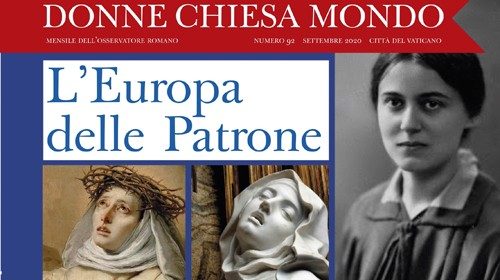
The new Europe cannot solely be founded on economics, finance, political agreements and diplomacy. This Europe needs collective values -and as strange as it may seem-, it needs common feelings able to guide it, to direct it, to interpret its deepest soul and to point to a hope for the future. For these ends, the patronesses of Europe, the saints, to whom the inhabitants of the old continent have entrusted themselves, are a source of models, values, and ways forward. Their holiness can transmit vitality and new strength to an idea that often falters; for this reason -amongst others-, we have dedicated an issue of Women Church World to them.
In 1999, the Church decided to entrust Europe to three patronesses: St. Bridget of Sweden; St. Catherine of Siena; and, St. Teresa Benedicta of the Cross. In selecting them, it established geographical unity, for Bridget comes from the far north of Europe; Catherine from Tuscany, and therefore represents the central and Mediterranean part of the continent; and, Teresa Benedicta of the Cross represents the countries in the east. However, the Church’s choice was not limited to their countries of origin.
Above all, the church recognized the role played by female holiness and affirmed the need to detect a difference between the male and female holinesses. These differences -namely the widely recognized male one, and the strong and widespread, yet indistinct one of women-, had evidently been overlooked until then. In the following pages, in the stories of the saints to whom each country has chosen to entrust itself and in those of the three co- patronesses of the European continent, we try to get to the roots of the feminine holiness to which Europe has entrusted itself. In addition, we reveal the values the old continent must take as its inspiration if it wants to have a future. In addition, and above all, we show the models which European women today, both believers and non-believers alike, can consider as the protagonists of still insufficient change. In this edition, the story of the patronesses’ lives has been entrusted to male and female scholars, and to some certain writers. Editorially, we have pursued the idea that literature can express different perspectives on the motions of the human soul, the infinite paths of faith -and therefore recount with greater richness the peculiar feminine holiness-, and the ways in which it is able to help us understand the world. The choice to go with this line is unusual, but it has turned out to be a successful one. The different modes of approach -both an abandonment to the story, and the inevitable identification with the object of one’s own narration-, reveal who these patron saints were, their messages, and the rich heritage they have bequeathed us, of which we can all widely refer to today. European feminine sanctity seems to us, above all, to be woven with confidence. This confidence in God became confidence in themselves and led the patronesses to carry out actions that seemed, and still seem, impossible. It was this absolute trust that drove Catherine, a poor and uneducated woman, to be a peacemaker that seemed impossible at a time torn by conflict. It was this trust that led her to ask the Church for consistency and moral rigor, to uproot “the rotten plants” and replace them “with fresh, flagrant new plants”. It was this infinite trust in God and in herself that led Bridget to leave her native Sweden, to come to Rome and to reveal God’s plans to the popes, and to warn them against sin. The European saints’ confidence in themselves and in life, became boldness. This led them to challenge the medieval male world, as it was for Catherine and Bridget, the more recent one for Edith Stein - in areas that seemingly belonged only to men: mysticism, the spiritual experience that connects us directly to God, without any mediation of men and the Church. Born into a Jewish family, and a student of the philosopher Husserl, Edith Stein, converted to Christianity, and then became a cloistered nun in Cologne. In August 1942 she was deported to Auschwitz and died in the death camp a week later; however, she claimed the union of her soul with God with strength and courage. It was precisely this union that induced her to carry out daring and inadmissible works. These led her to explore the richness of femininity and the concrete condition of women, and to make this a cultural and social battleground.
The saints, whose histories we report on here, travelled a great deal. They travelled through Europe and Italy, crossing seas and over mountains. The pilgrimage in their lives is a dimension of the soul and another demonstration of their special relationship with God. They use it for their knowledge, to change people and things, to intervene in the disputes of their time, and in the events of the Church. Their journeys are also interior pilgrimages, in search of themselves and of a special relationship with the divine. It was Saint Teresa of Avila’s experience of a closeness to God who revealed himself moment by moment, or rather how, gradually, God entered her heart. It is that of Saint Teresa of Lisieux, who discovered, in the thirst for childhood love, the love of God and towards God. In order to be a candidate for a leading role that incorporates strength and authority, one must have great confidence in oneself. It is this confidence that leads to an ability to propose oneself to God with the same strength and determination as the patronesses of Europe.
Today, it is this strength and authority that thy hand over to us. And for men, and especially for European women, this is no small matter.
Ritanna Armeni













 Purchase the Encyclical here Fratelli Tutti
Purchase the Encyclical here Fratelli Tutti
